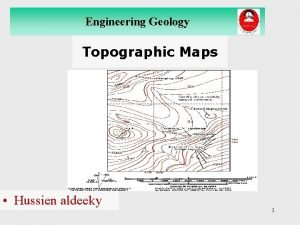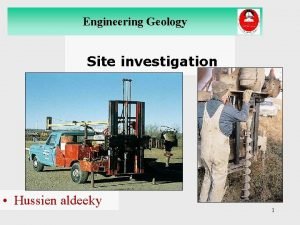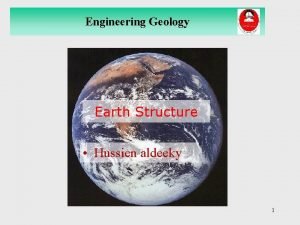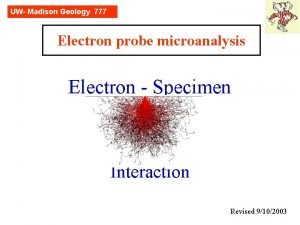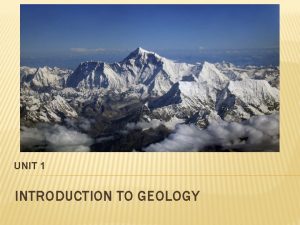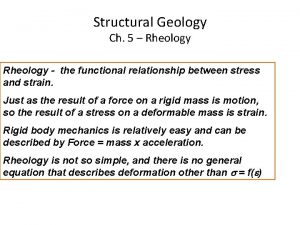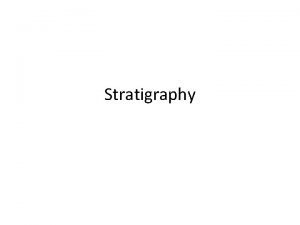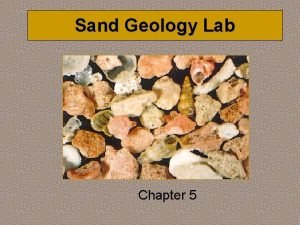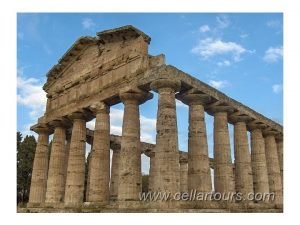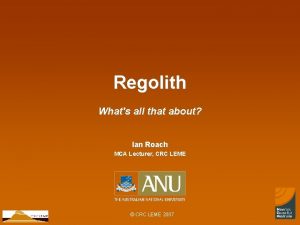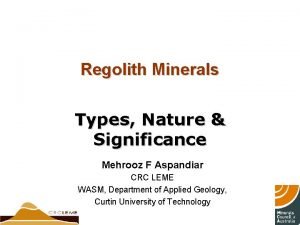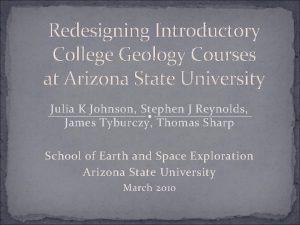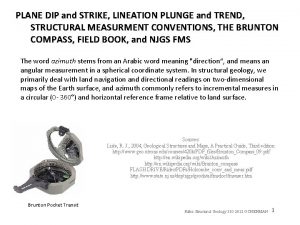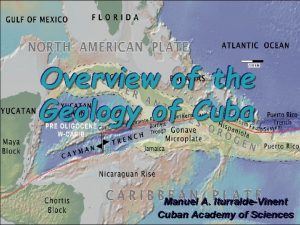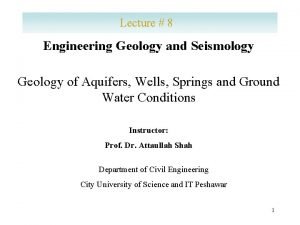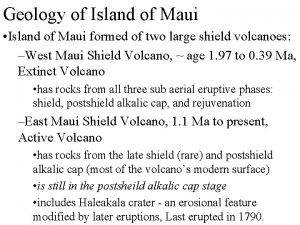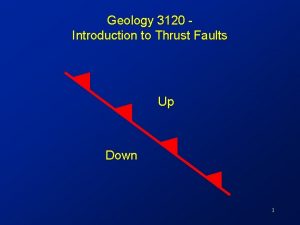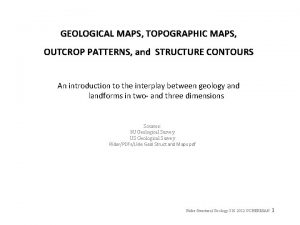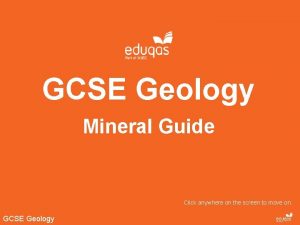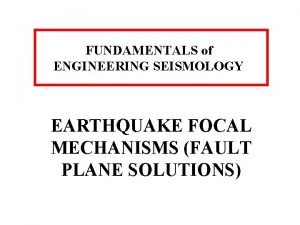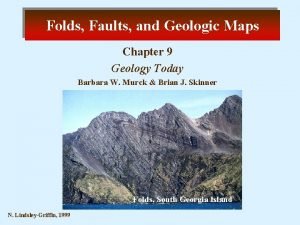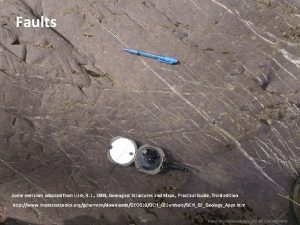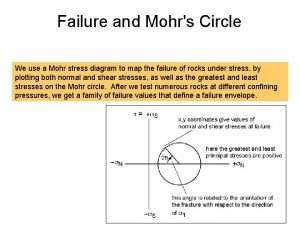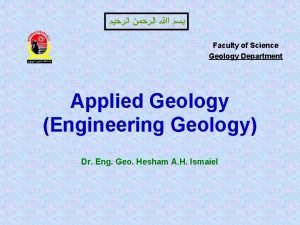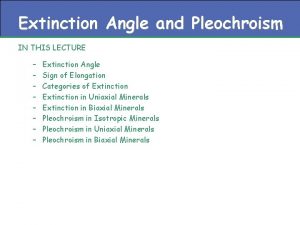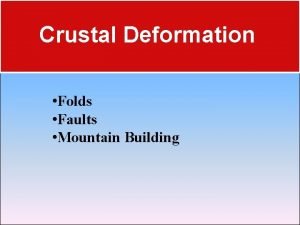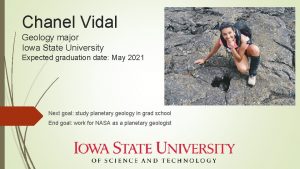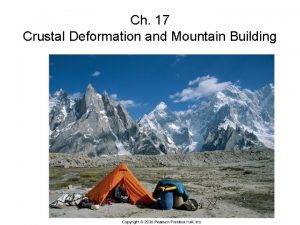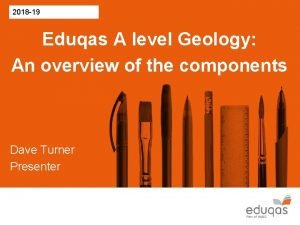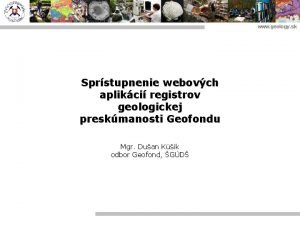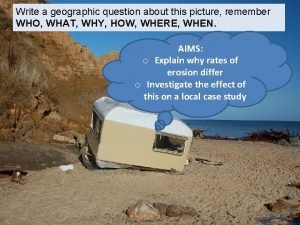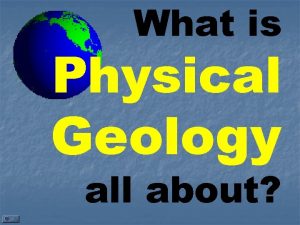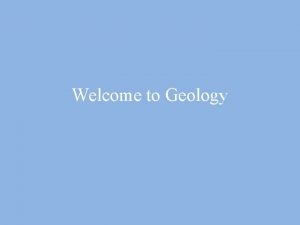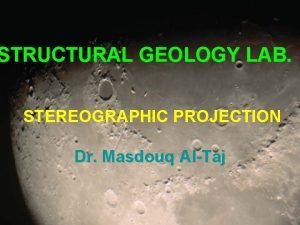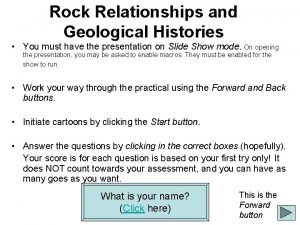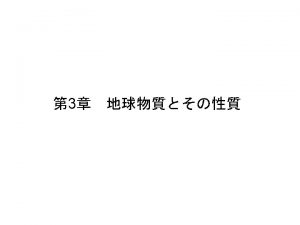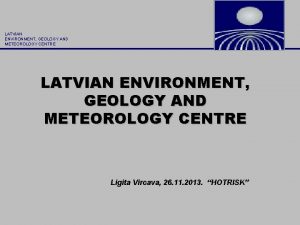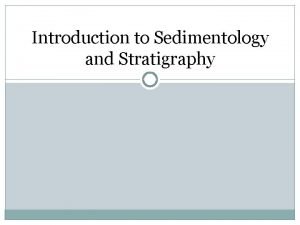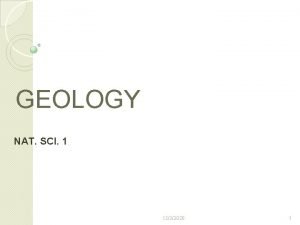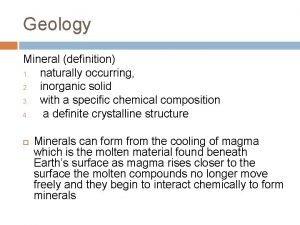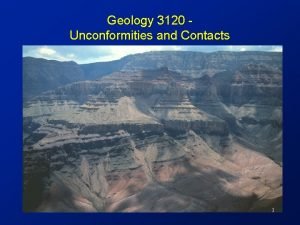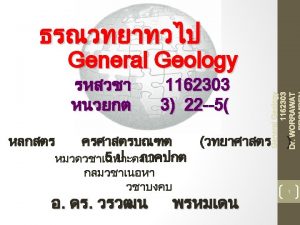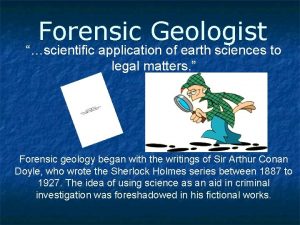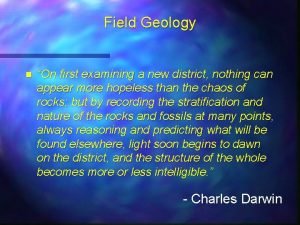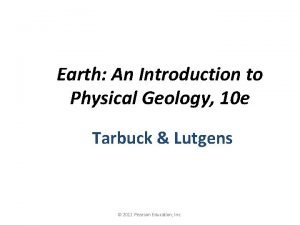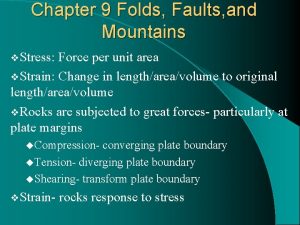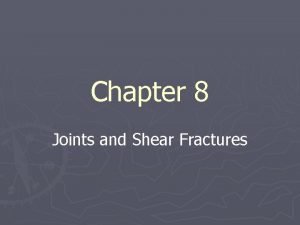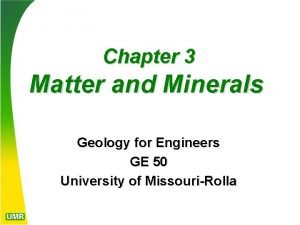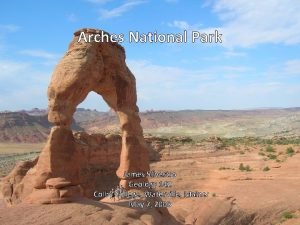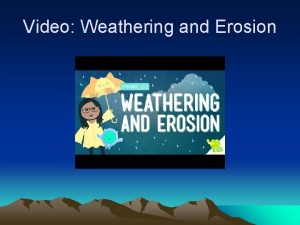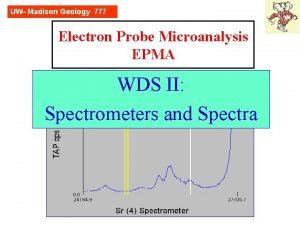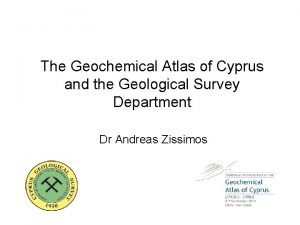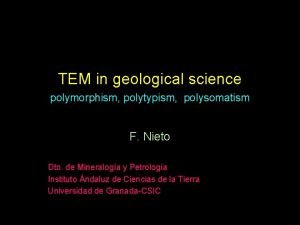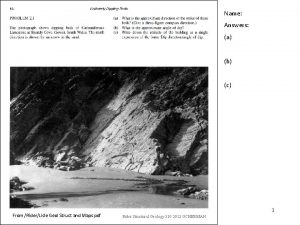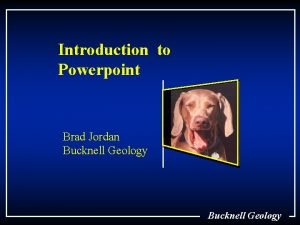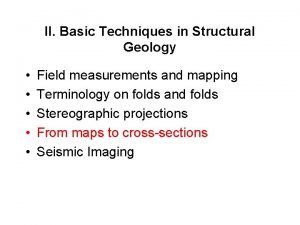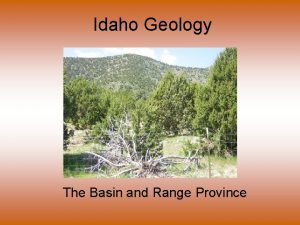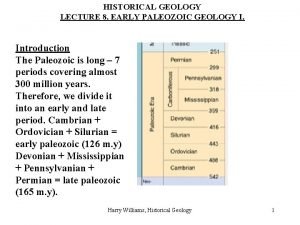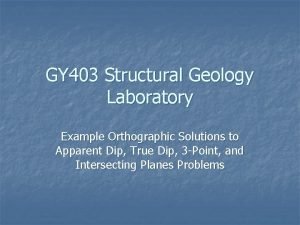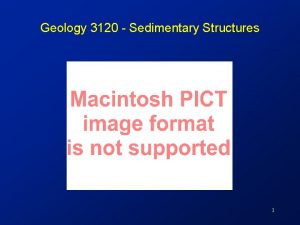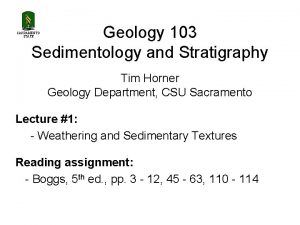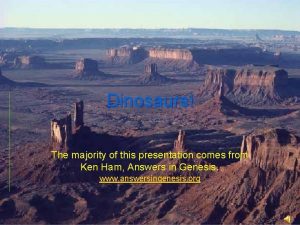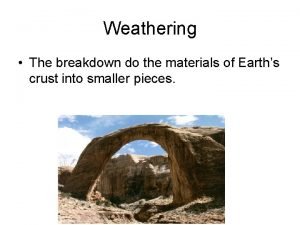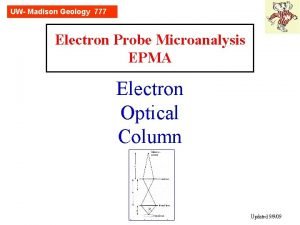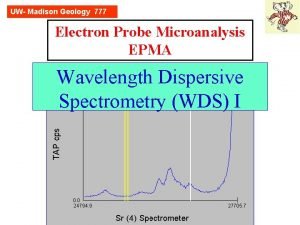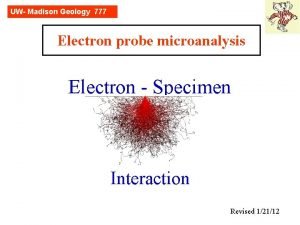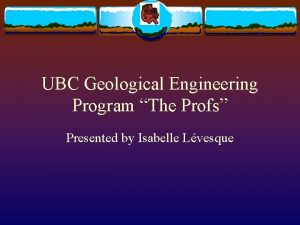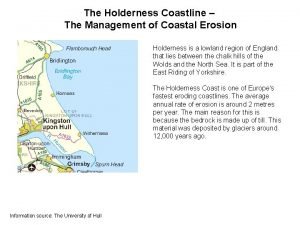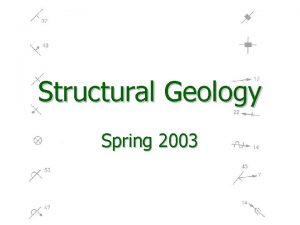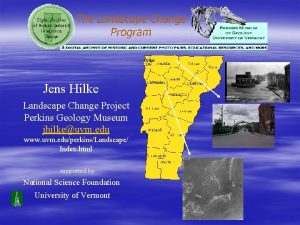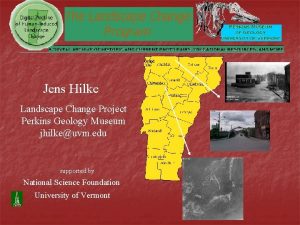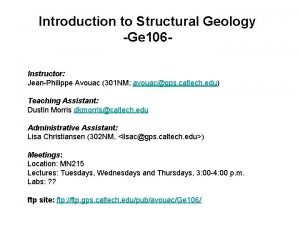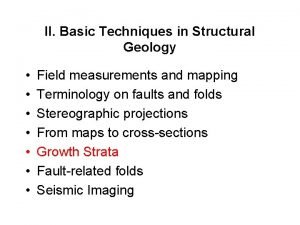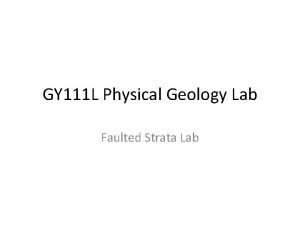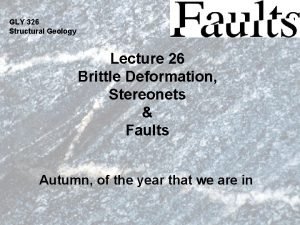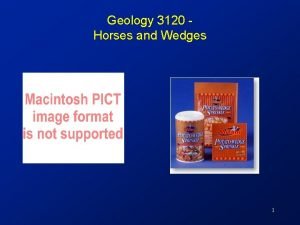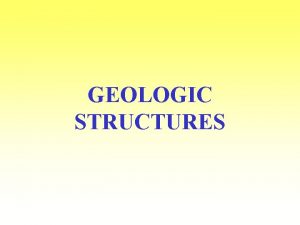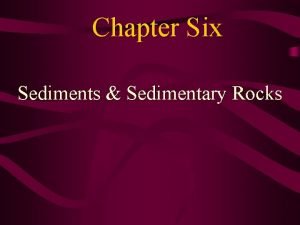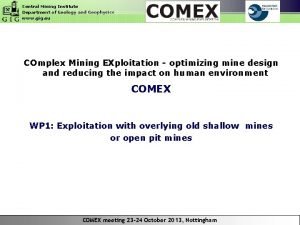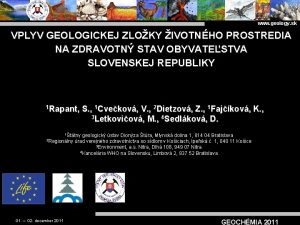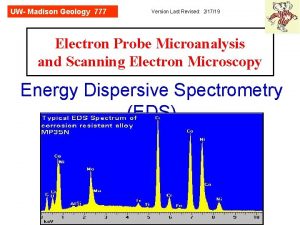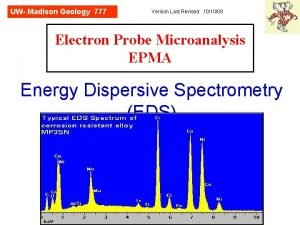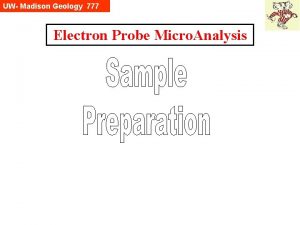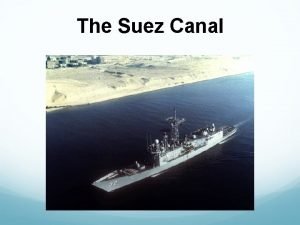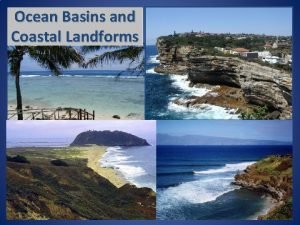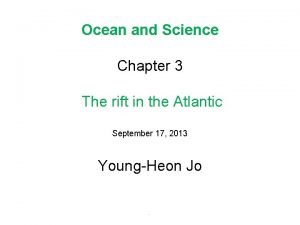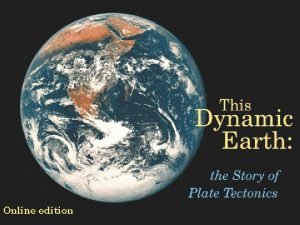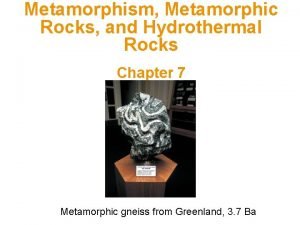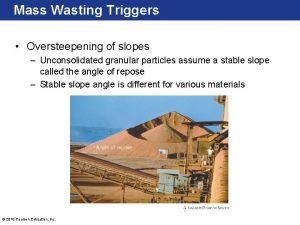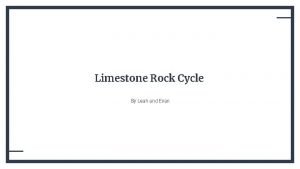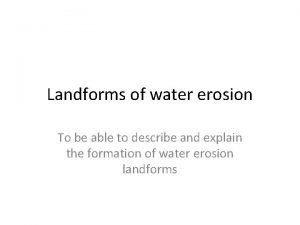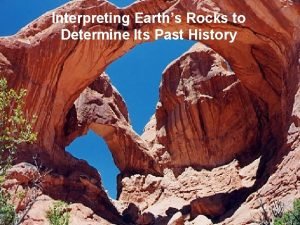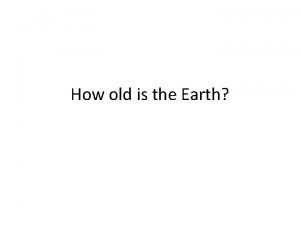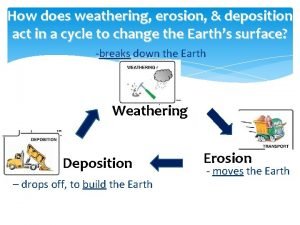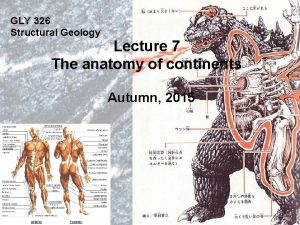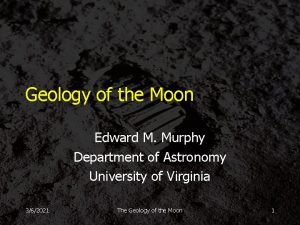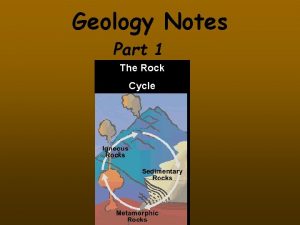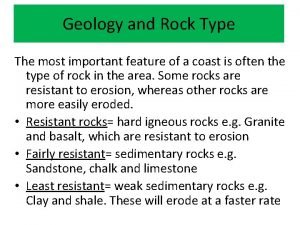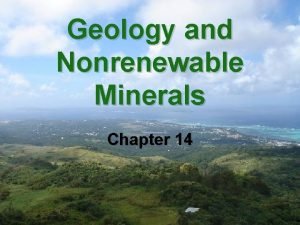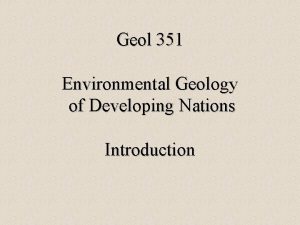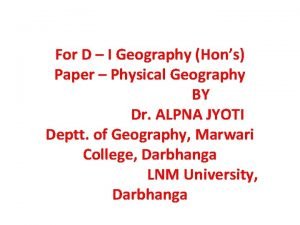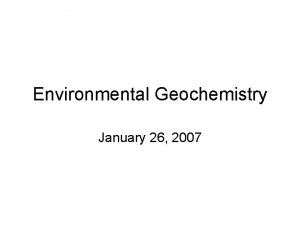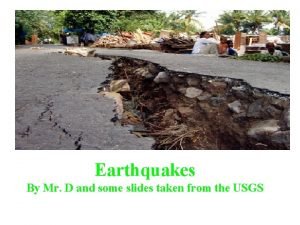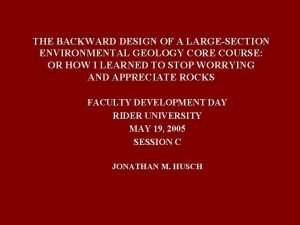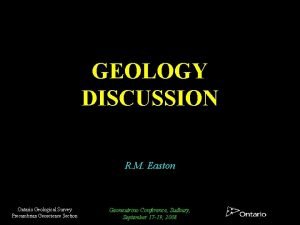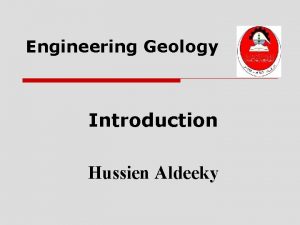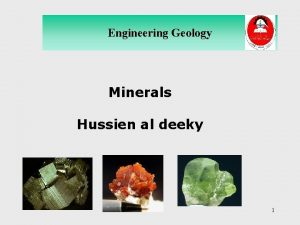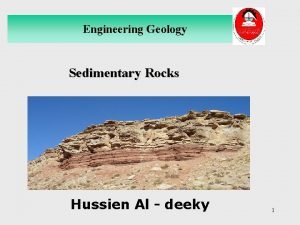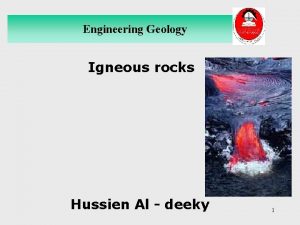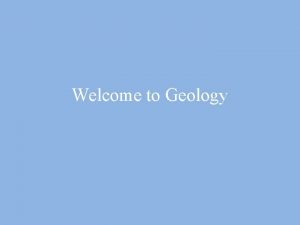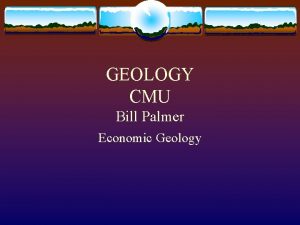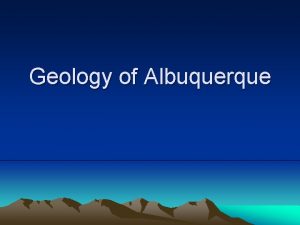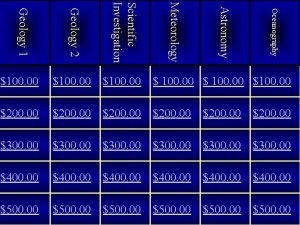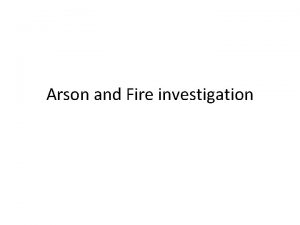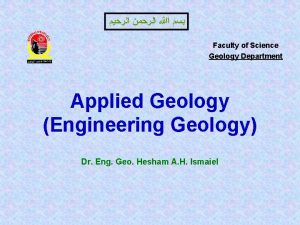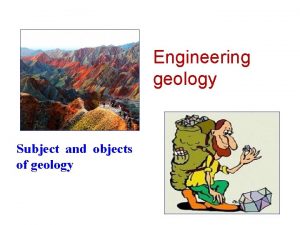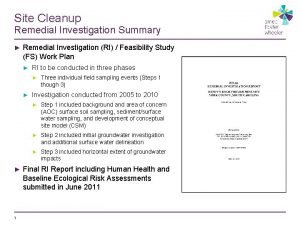Engineering Geology Site investigation Hussien aldeeky 1 Engineering
























































































































- Slides: 120

Engineering Geology Site investigation • Hussien aldeeky 1

Engineering Geology Definition The process of determining the layers of natural soil deposits that will underlie a proposed structure and their physical properties is generally referred to as site investigation. The purpose of a soil investigation program 1. Selection of the type and the depth of foundation suitable for a given structure. 2. Evaluation of the load-bearing capacity of the foundation. 2

Engineering Geology 3. Estimation of the probable settlement of a structure. 4. Determination of potential foundation problems (for example, expansive soil, collapsible soil, sanitary landfill, and so on). 5. Establishment of ground water table. 6. Prediction of lateral earth pressure for structures like retaining walls, sheet pile bulkheads, and braced cuts. 7. Establishment of construction methods for changing subsoil conditions

Engineering Geology exploration program The purpose of the exploration program is to determine, within practical limits, the stratification and engineering properties of the soils underlying the site. The principal properties of interest will be the strength, deformation, and hydraulic characteristics. The program should be planned so that the 4 be obtained at minimum cost. maximum amount of information can 1. Assembly of all available information on dimensions, column spacing, type and use of the structure, basement requirements, and any special architectural considerations of the proposed building. Foundation regulations in the local building code should be consulted for any special requirements. For bridges the soil engineer should have access to type and span lengths as well as pier loadings. This information will indicate any settlement limitations, and can be used to estimate foundation loads. 4

Sequences of Stages for investigation Desk Study: Literature Search : first stage of the Site Investigation The desk study is work taken up prior to commencing the work on site and the Ground Investigation. and is used to plan the Ground Investigation. A good starting point is to use the: 1. geological maps. In addition to historical maps. That allow much information to be obtained such as former uses of the site; concealed mine workings; in- filled ponds; old clay, gravel and sand pits; disused quarries; changes in topography and drainage; changes in stream and river courses; changes in potential landslide areas. 2. Ariel Photography is another useful source of information. Such records can be extremely useful in ascertaining historical use of the site, hidden foundations, changes of river course and much other hidden data. 3. Services records are also an essential part of the desk study, necessary to locate hidden services such as electricity cables, sewers and telephone wires. It is essential when conducting a desk study that as much information as possible is obtained. Work at this stage of the Investigation saves much time later and vastly improves the planning and quality of the Investigation 5

6

Aims and benefits of a desk study: • To collect, understand interpret data • To limit costs • Aid in the Design Process • Highlights problems early • Low cost & cost effective • Provides information which would otherwise be difficult to obtain 7

Sources of information • Maps • Geological maps & Memoirs • Current OS Maps • Old Maps / Aerial Photos • Archive –Historical Geotechnical Info. –Engineering Drawings –Construction Records –Libraries • Specialist Surveys –Environmental Check, Landfill etc. –Mining Records –Ecological Survey • Observational –Site Visit / Walkover survey –People ( Construction Staff, Local Residents 8

Engineering Geology 2. Reconnaissance of the area: This may be in the form of a field trip to the site which can reveal information on the type and behavior of adjacent structures such as cracks, noticeable sags, and possibly sticking doors and windows. The type of local existing structure may influence, to a considerable extent, the exploration program and the best foundation type for the proposed adjacent structure. 3. A preliminary site investigation: In this phase a few borings are made or a test pit is opened to establish in a general manner the stratification, types of soil to be expected, and possibly the location of the groundwater table. One or more borings should be taken to rock, or competent strata, if the initial borings indicate the upper soil is loose or highly compressible. This amount of exploration is usually the extent of the site investigation for small structures. 9

Site Reconnaissance The Site Reconnaissance phase of a site investigation is normally in the form of a walk over survey of the site to recognise any difficult ground conditions. Important evidence to look for is: • Hydrogeology: Wet marshy ground, springs or seepage, ponds or streams and Wells. • Slope Instability: Signs of slope instability include bent trees, and displaced fences or drains. • Mining: The presence of mining is often signs of subsidence and possibly disused mine shafts. Open cast mining is indicated by diverted streams replaced or removed fence/hedge lines. • Access: It is essential that access to the site can be easily obtained. Possible problems include low overhead cables and watercourses 10

Difficult Ground Conditions An efficient ground investigation recognizes, during the initial desk study, the possibilities or probabilities of any specific difficult ground conditions occurring within the project site It then direct the field work exploration to either eliminate the considered possibilities or determine the extent of the ground difficulties The most common difficulties are: • Soft and variable dirt materials • Weathered, weak or fractured bedrock • Natural or artificial cavities within the bedrock • Active or potential slope failure and land slides • Compressive landfill with or without soft spots • Flowing groundwater or methane gas • Unexpected old building foundations 11

Engineering Geology 4. A detailed site investigation: Where the preliminary site investigation has established the feasibility of the project, a more detailed exploration program is undertaken. The preliminary borings and data are used as a basis for locating additional borings, which should be confirmatory in nature, and determining the additional samples required. Depth of Boring The approximate required minimum depth of the borings should be predetermined. The estimated depths can be changed during the drilling operation, depending on the subsoil encoun tered. To determine the approximate minimum depth of boring, engineers may use the following rule:

Engineering Geology 1. Determine the net increase of stress, under a foundation with depth as. shown in the Figure. 2. Estimate the variation of the vertical effective stress, ' , with depth 3. Determine the depth, D = D 1, at which the stress increase is equal to (1/10) q (q = estimated net stress on the foundation). 4. Determine the depth, D = D 2, at which / ' = 0. 05. 5. Unless bedrock is encountered, the smaller of the two depths, D 1 and D 2, just determined is the approximate minimum depth of boring required. Table shows the minimum depths of borings for buildings based on the preceding rule.

Engineering Geology Determination of the minimum depth of boring 14

Engineering Geology .

Engineering Geology For hospitals and office buildings, the following rule could be use to determine boring depth.

17

18

Depth of borehole for isolated footing 1. Isolated spread footing or raft: D= 1. 5 B below the lowest part of the foundation 2. Adjacent isolated footings with A< 2 B: D= 1. 5 L below the lowest part of the foundation 19

20

21

Engineering Geology When deep excavations are anticipated, the depth of boring should be at, least 1. 5 times the depth of excavation. Sometimes subsoil conditions are such that the foundation load may have to be transmitted to the bedrock. The minimum depth of core boring into the bedrock is about 3 m. If the bedrock is irregular or weathered, the core borings may have to be extended to greater depths. Spacing Boring There are no hard and fast rules for the spacing of the boreholes. The following table gives some general guidelines for borehole spacing. These spacing can be increased or decreased, depending on the subsoil condition. If various soil strata are more or less uniform and predictable, the number of boreholes can be reduced. 22

Engineering Geology THE MOHO Approximate Spacing of Boreholes

Selection of Borings 24

25

26

27

Engineering Geology SOIL BORING The earliest method of obtaining a test hole was to excavate a test pit using a pick and shovel. Because of economics, the current procedure is to use power-excavation equipment such as a backhoe to excavate the pit and then to use hand tools to remove a block sample or shape the site for in situ testing. This is the best method at present for obtaining quality undisturbed samples or samples for testing at other than vertical orientation.

Trial Pits : Trial pits are shallow excavations going down to a depth no greater than 6 m. It is used extensively at the surface for block sampling and detection of services prior to borehole excavation. care should be taken as gases such as methane and carbon dioxide can build up in a trial pit. Breathing apparatus must therefore be used if no gas detection equipment is available. Support for a trial pit generally takes one of three forms: • Timbering • Steel frames with hydraulic jacks • Battered or tapered sides 29

Engineering Geology a test pit 30

Block sampling has traditionally involved the careful hand excavation of soil around the sample position, and the trimming of a regular shaped block. This block is then sealed, before being encased in a rigid container, and cut from the ground. Undisturbed block sampling is limited to cohesive soils and rocks. The procedures used for obtaining undisturbed samples vary from cutting large blocks of soil using a combination of shovels, hand tools and wire saws, to using small knives and spatulas to obtain small blocks 31

Boreholes: used to determine the nature of the ground (usually below 6 m depth) in a qualitative manner and then recover undisturbed samples for quantitative examination 32

Engineering Geology Boring tools Auger boring Power drills

Engineering Geology Wash Borings. is one of the methods of advancing a borehole. A steel casing (a hollow tube), typically 6 feet long, is driven into the ground. The soil inside the casing is removed by means of a chopping bit that is attached to a drilling rod. The loose soil particles are washed out with a water jet, which is collected at the surface in a container, where the engineer can observe the material coming up at each depth.

Engineering Geology Drilling Mud Drilling throughout rock is assisted with the aid of Bentonite( type of clay) that lubricate the drilling bit 35

Engineering Geology Preparation of Boring Logs 1. Name and address of the drilling company 2. Driller’s name 3. Job description and number 4. Number, type, and location of boring 5. Date of boring 6. Subsurface stratification, which can he obtained by visual observation of the soil brought out by auger, split spoon sampler, and thin walled Shelby tube sampler 7. Elevation of water table and date observed, use of casing and mud losses, and so on 8. Standard penetration resistance and the depth of SPT 9. Number, type, and depth of soil sample collected 10. In case of rock coring, type of core barrel used and, for each run, the actual length of coring, length of core recovery, and ROD 36

Engineering Geology THE MANTLE

38

39

40

Engineering Geology THE CORE SOIL SAMPLING Two types of soil samples can be obtained during sampling disturbed and undisturbed. The most important engineering properties required for foundation design are strength, compressibility, and permeability. Reasonably good estimates of these properties for cohesive soils can be made by laboratory tests on undisturbed samples which can be obtained with moderate difficulty. It is nearly impossible to obtain a truly undisturbed sample of soil; so in general usage the term "undisturbed" means a sample where some precautions have been taken to minimize disturbance or remolding effects. In this context, the quality of an "undisturbed" sample varies widely between soil laboratories. so il Good quality samples necessary. sampling tube area ratio AR<10%

Engineering Geology.

Engineering Geology Common Sampling Methods 43

44

Engineering Geology Earth’s Structure ROCK SAMPLING Rock cores are necessary if the soundness of the rock is to be established. small cores tend to break up inside the drill barrel. Larger cores also have a tendency to break up (rotate inside the barrel and degrade), especially if the rock is soft or fissured. 45

Engineering Geology Rock coring 46

Engineering Geology Drill bits for rock penetration 47

Engineering Geology ROCK SAMPLING - Definition 48

Engineering Geology Rock Core Drilling Done with either tungsten carbide or diamond core bits Use a double or triple tube core barrel when sampling weathered or fractured rock Used to determine Rock Quality Designation core barrel 49

Engineering Geology Stony Meteorites Rock Quality Designation RQD 50

Engineering Geology RQD Rock Quality Designation (RQD) is defined as the percentage of rock cores that have length equal or greater than 10 cm over the total drill length. 51

Engineering Geology Example on Core Recovery & RQD Core run of 150 cm Total core recovery = 125 cm Core recovery ratio = 125/150 = 83% On modified basis, 95 cm are counted RQD = 95/150=63 % 52

53

Properties Governing Rock Mass Behavior Rock mass is a matrix consisting of rock material and rock discontinuities. rock discontinuity are: joints. Faults, bedding planes and dyke intrusions. Properties of rock mass therefore are governed by the parameters of rock joints and rock material, as well as boundary conditions, . T he behavior of rock changes from continuous elastic of intact rock materials to discontinues running of highly fractured rock masses 54

Rock Mass Rating System (RMR) Is a rock classification system uses five basic parameters for classification and properties evaluation. A sixth parameter helps further assess issues of stability to specific problems. Originally intended for tunneling & mining applications, it has been extended for the design of cut slopes and foundations. [stand--up time of an unsupported excavation ] The six parameters used to determine the RMR * value are: Uniaxial compressive strength (σu). • Rock Quality Designation (RQD) • Spacing of discontinuities • Condition of discontinuities • Groundwater conditions • Orientation of discontinuities ( dip and strike of discontinuities, plane of weakness) *Note: Value may be estimated from point load index (Is). The rating is obtained by summing the values assigned for the first five components 55

56

57

58

59

The Geo mechanics Classification System for Rock Mass Rating (RMR) 60

Engineering Geology GROUND WATER TABLE LEVEL Groundwater conditions and the potential for groundwater seepage are fundamental factors in virtually all geotechnical analyses and design studies. Accordingly, the evaluation of groundwater conditions is a basic element of almost all geotechnical investigation programs. Groundwater investigations are of two types as follows: Determination of groundwater levels and pressures. Measurement of the permeability of the subsurface materials. 61

Engineering Geology FIELD STRENGTH TESTS The following are the major field tests for determining the soil strength: 1. Vane shear test (VST). 2. Standard Penetration Test (SPT). 3. Cone Penetration Test (CPT). 4. The Borehole Shear Test (BST). 5. The Flat Dilatometer Test (DMT). 6. The Pressure-meter Test (PMT). 7. The Plate Load Test (PLT). 62

Engineering Geology 63

Engineering Geology 64

Engineering Geology Standard Penetration Test (SPT) is an in situ dynamic penetration test to provide information on the geotechnical engineering properties of soil N Value The test uses a thick walled sample tube, with an outside diameter of 50 mm and an inside diameter of 35 mm, and a length of around 650 mm. This is driven into the ground at the bottom of a borehole by blows from a slide hammer with a weight of 63. 5 kg. falling through a distance of 760 mm. The sample tube is driven 150 mm into the ground and then the number of blows needed for the tube to penetrate each 150 mm up to a depth of 450 mm is recorded. The sum of the number of blows required for the second and third 150 mm of penetration is termed the "standard penetration resistance" or the "N value". In cases where 50 blows are insufficient to advance it through a 150 mm interval the penetration after 50 blows is recorded. The blow count provides an indication of the density of the ground, . The main purpose of the test is to provide an indication of the relative density of granular deposits, such as sands and gravels from which it is virtually impossible to obtain undisturbed samples. 65

Engineering Geology 66

Engineering Geology Em: Hammer efficiency =0. 6 for safety hammer and = 0. 45 for doughnut hammer 67

Engineering Geology 68

Engineering Geology 69

Engineering Geology Corrections are normally applied to the SPT blow count to account for differences in: • energy imparted during the test (60% hammer efficiency) • the stress level at the test depth The following equation is used to compensate for the testing factors (Skempton, 1986): 70

Engineering Geology 71

Engineering Geology 72

Engineering Geology Permeability 73

Engineering Geology Coefficient of permeability in different soils Permeability is the ease with which the water flows through a soil medium 74

Engineering Geology Cone Penetration Test (CPT) . 75

Engineering Geology 76

Engineering Geology 77

Engineering Geology Push the sounding rod with cone into the ground for some specified depth. Then push the cone with friction sleeve for another specified depth (> 35 mm). Repeat the process with/without friction sleeve. �Pushing rate = 1 cm/s �Mantle tube is push simultaneously such that it is always above the cone and friction sleeve. �Tip Load, Qc = Load from pressure gauge reading + Wt. of cone + Wt. of connecting sounding rods 78

Engineering Geology 79

Engineering Geology 80

Engineering Geology CPT Results & Soil Classification 81

Engineering Geology 82

Engineering Geology 83

Engineering Geology CPT: Advantages over SPT �provides much better resolution, reliability �versatility; pore water pressure, dynamic soil properties �CPT: Disadvantages �Does not give a sample �Will not work with soil with gravel �Need to mobilize a special rig 84

Engineering Geology Vane Shear Test (VST) For clays, and mainly for soft clays. �Measure torque required to quickly shear the vane pushed into soft clay. torque �undrained shear strength cu �Typical d = 20 100 mm. 85

Engineering Geology 86

Engineering Geology 87

Engineering Geology ADVANTAGES of VST • Assessment of undrained strength, su • Simple test and equipment • Measure in situ clay sensitivity (St) • Long history of use in practice DISADVANTAGES of VST • Limited application to soft to stiff clays with su < 200 k. Pa • Slow and time consuming • Raw suv needs (empirical) correction • Can be affected by sand lenses and seams 88

Engineering Geology The Plate Load Test (PLT) 89

Engineering Geology 90

Engineering Geology 91

Engineering Geology ` Scale Effect in Foundation Design 92

Engineering Geology dilatometer test (DMT) 93

Engineering Geology The flat dilatometer test (DMT) uses pressure readings from an inserted plate to obtain stratigraphy and estimates of at-rest lateral stresses, elastic modulus, and shear strength of sands, silts, and clays. Soils than can be tested by DMT Suitable for SANDS, SILTS, CLAY (grains small vs. membrane D=60 mm). But can cross through GRAVEL layers ≈ 0. 5 m • Very robust, can penetrate soft rocks (safe push on blade 25 ton) • Clays : cu = 2 4 KPa to cu= 10 bar (marls) • Moduli : 5 to 4000 bar (0. 5 to 400 MPa) • Penetrates fast and easily in hard soils PROVIDED sufficient pushing capacity (e. g. 20 ton trucks). 94

Engineering Geology ADVANTAGES OF DMT • Simple and robust • Repeatable & operator independent • Quick and economical DISADVANTAGES OF DMT • Difficult to push in dense and hard materials • Primarily relies on correlative relationships • Need calibrations for local geologies 95

Engineering Geology 19 Devices Flat Plate Dilatometer Equipment: (a) Modern Dual Element Gauge System; (b) Early Single Gauge Readout; (c) Computerized Data Acquisition Model. 96

Engineering Geology Results from DMT The two DMT readings (po and p 1) are utilized to provide three indices that can provide information on the stratigraphy, soil types, and the evaluation of soil parameters: Material Index: ID = (p 1 - po)/(po - uo) Dilatometer Modulus: ED = 34. 7(p 1 - po) Horizontal Stress Index: KD = (po - uo)/σv 0’ where uo = hydrostatic pore-water pressure σv 0’= effective vertical overburden str 97

Engineering Geology Example results from a DMT conducted in Piedmont residual soils, including the measured lift off (p 0) and expansion (p 1) pressures, material index (ID), dilatometer modulus (ED), and horizontal stress index (KD) versus depth. 98

Engineering Geology Interpretation of soil properties soil classification For soil behavioral classification, layers are interpreted as clay when ID < 0. 6, silts within the range of 0. 6 < ID < 1. 8, and sands when ID >1. 8. 99

Engineering Geology 100

Engineering Geology K 0 in soils • K 0 in clay The original correlation for K 0, relative to uncemented clays (Marchetti 1980), is: K 0 = (KD /1. 5) 0. 47 0. 6 • K 0 in sand Baldi et al. (1986) updated such K 0 qc KD chart (qc = CPT cone resistance) by incorporating all subsequent calibration chamber work. Moreover the chart was converted into simple algebraic equations: K 0 = 0. 376 + 0. 095 KD 0. 0017 qc /σ'v 0 (1) K 0 = 0. 376 + 0. 095 KD 0. 0046 qc /σ'v 0 (2) OCR 101

Engineering Geology For un drained cohesion in clay For soil friction angle For modulus of elasticity 102

Engineering Geology Pressure meter Test (PMT) Determined : Elastic Young Mod, E Shear Mod, G Undrained shear strength, Su 103

Engineering Geology Measurements: 1. Fluid Pressure 2. Fluid volume change. Plate 104

Engineering Geology Geophysical Exploration Seismic Refraction Survey Seismic refraction surveys are useful in obtaining preliminary information about the thickness of the layering of various soils and the depth to rock or hard soil at a site. Refraction surveys are conducted by impacting the surface, as at point A in figure 2. 41 a and observing the first arrival of the disturbance (stress waves) at several other points (e. g. , B, C, D, …). The impact can be created by a hammer blow or by a small explosive charge. The first arrival of disturbance waves at various points can be recorded by geophones 105

Engineering Geology 106

Engineering Geology Seismic refraction survey 107

Engineering Geology The impact on the ground surface creates two types of stress wave: P waves (or plane waves) and S waves (or shear waves). The P waves travel faster than S waves; hence the first arrival of disturbance waves will be related to the velocities of the P waves in various layers. The velocity of P waves in a medium is Where �� s =modulus of elasticity of the medium Ρ = Density of medium =µPoisson′sratio 108

Engineering Geology To determine the velocity, v, of P waves in various layers and the thicknesses of those layers, use the following procedure. 1. Obtain the times of first arrival, �� 1, �� 2, �� 3, …, at various distances, �� 1, �� 2, �� 3, …, from the point of impact. 2. Plot a graph of time, t, against distance, x. the graph will look like the one shown in figure 2. 41 b. 3. Determine the slopes of the lines �� b, �� c, �� d, … Slope of �� b= 1/�� 1 Slope of �� c= = 1/�� 2 Slope of �� d = 1/�� 3 Where �� 1, �� 2, �� 3, … are the P-wave velocities in layers I, III, …. , respectively (figure 2. 41 b ) 109

Engineering Geology 4. Determine thickness of the top layer as The value of ���� can be obtained from the plot, as shown in figure 5. Determine thickness of the second layer, �� 2, shown in figure , as 110

Engineering Geology 111

Engineering Geology Example The results of a refraction survey at a site are given in the following table. Determine the P-wave velocities and the thickness of the material encountered Distance from source(m) Time first arrial (sec× 103) 2. 5 11. 2 5 23. 3 7. 5 33. 5 10 42. 5 15 50. 9 20 57. 2 25 64. 4 30 68. 6 35 71. 1 40 72. 1 45 75. 5 112

Engineering Geology Solution Velocity In figure below , the times of first arrival are plotted against the distance from the source of disturbance. The plot has three straight line segments. The velocity of the top three layers can now be calculated as follows Slope of segment 0�� = 1/�� 1= time /distance = 23× 10− 3/5. 25 Or �� 1=5. 25× 10 3/23=228 m/sec�(top layer) Slope of segment �� b =1/�� 2=13. 5× 10− 3/11 Or �� 2 = 11× 10 3/13. 5 = 814. 8 m/sec�(middle layer) Slope of segment �� c= 1/�� 3= 3. 5× 10− 3/14, 75 Or V 3 = 4214 m/sec(third layer) 113

Engineering Geology 114

Engineering Geology Comparing the velocities obtained here with those given in table 10 indicates that the third layer is a rock layer. Thickness of Layers From figure, ���� = 10. 5 m, so 115

Engineering Geology =12. 66 m Thus , the rock layer lies at depth of Z 1+Z 2 = 3. 94+12. 66 = 16. 6 m 116

Engineering Geology Cross-Hole Seismic Survey Figure Cross hole method of seismic survey 117

Engineering Geology The velocity of shear waves created as the result of an impact to a given soil layer can be effectively determined by cross-hole seismic survey (Stokoe and Woods, 1972). The principle of this technique is illustrated in figure below , which shows two holes drilled into the ground at distance L apart. A vertical impulse in created at the bottom of one borehole by means of an impulse rod. The shear waves thus generated are recorded by a vertically sensitive transducer. The velocity of shear waves, ���� , can be calculated as �� =travel time of shear waves 118

Engineering Geology The shear modulus of the soil at the depth of the test can be determined from Where �� s =shear modulus of soil = �� soil unit weight g =acceleration due to gravity 119

Site Investigation Cost Saving on the ground investigation budget generally prove to be false economies After an inadequate ground investigation, unforeseen ground conditions can and frequently raise project costs by 10% or more 120
 Geology
Geology Cpt soil
Cpt soil Geospere
Geospere V shaped contour lines
V shaped contour lines Hot site cold site warm site disaster recovery
Hot site cold site warm site disaster recovery Xvfk
Xvfk Geology
Geology Geology what is
Geology what is Geology
Geology Types of folds geology
Types of folds geology Geology lecture series
Geology lecture series Grain size card geology
Grain size card geology Differential stress rock
Differential stress rock Whats regolith
Whats regolith Mineral council australia
Mineral council australia Arizona state university geology
Arizona state university geology Difference between dip and plunge
Difference between dip and plunge Geology of cuba
Geology of cuba Confined aquifer vs unconfined aquifer
Confined aquifer vs unconfined aquifer Maui geology
Maui geology Thrust geology
Thrust geology Rule of v's structural geology
Rule of v's structural geology Mica mineral hardness
Mica mineral hardness Gcse geology
Gcse geology Beach ball seismology
Beach ball seismology Maps
Maps Structural geology practical exercises
Structural geology practical exercises Confining pressure mohr circle
Confining pressure mohr circle Geology earth science definition
Geology earth science definition Symmetrical extinction
Symmetrical extinction Astronomy definition earth science
Astronomy definition earth science Earth science vs geology
Earth science vs geology Department of geology university of dhaka
Department of geology university of dhaka Evento
Evento Chanel vidal
Chanel vidal Accretion (geology)
Accretion (geology) Eduqas geology
Eduqas geology Earth science branches
Earth science branches Www.geology.sk
Www.geology.sk Geology map of holderness coast
Geology map of holderness coast Define physical geology
Define physical geology Geology vocabulary
Geology vocabulary Stereographic projection structural geology
Stereographic projection structural geology Conformable contact geology
Conformable contact geology Prem earth model
Prem earth model Latvian environment geology and meteorology centre
Latvian environment geology and meteorology centre What are sediments?
What are sediments? Geology definition
Geology definition Inorganic geology definition
Inorganic geology definition Disconformity definition geology
Disconformity definition geology Geology
Geology Forensic geologist definition
Forensic geologist definition Rule of v's geology
Rule of v's geology Radioactivity definition geology
Radioactivity definition geology Oil accumulation
Oil accumulation Joints geology
Joints geology Essentials of geology
Essentials of geology Arches national park geology
Arches national park geology Exfoliation weathering definition
Exfoliation weathering definition Geology
Geology Geology of cyprus
Geology of cyprus Five themes of geology
Five themes of geology Polytypism geology
Polytypism geology Name
Name Introduction to geology ppt
Introduction to geology ppt Structural geology
Structural geology Basin and range geology
Basin and range geology Historical geology
Historical geology Three point problem geology
Three point problem geology Load cast structure
Load cast structure Sac state geology
Sac state geology Entouka meaning
Entouka meaning Type of weathering
Type of weathering Geology
Geology Geology
Geology Geology
Geology Dharma wijewickreme
Dharma wijewickreme Holderness coast sediment cell
Holderness coast sediment cell Pumpelly's rule geology
Pumpelly's rule geology Uvm landscape change
Uvm landscape change Perkins geology museum
Perkins geology museum Structural geology
Structural geology Geology
Geology Geology
Geology Stratalab
Stratalab Brittle deformation geology
Brittle deformation geology Geology
Geology Syncline
Syncline Loose solid particles
Loose solid particles Geology
Geology Geology sk
Geology sk Goldstein
Goldstein Geology
Geology Geology
Geology Panama canal in world map
Panama canal in world map Dome geology
Dome geology Terrace
Terrace Future continents
Future continents Slab pull
Slab pull Cleavage in geology
Cleavage in geology Mass wasting
Mass wasting Limestone rock cycle
Limestone rock cycle Mesa and butte diagram
Mesa and butte diagram Angular unconformities
Angular unconformities Lateral continuity
Lateral continuity Grade 2 science worksheets
Grade 2 science worksheets Structural geology
Structural geology Geology
Geology Regional metamorphism
Regional metamorphism Lulworth cove rock types
Lulworth cove rock types Geology
Geology Geology
Geology Geol 351
Geol 351 Voueu
Voueu Mountain
Mountain What is geochemistry in geology
What is geochemistry in geology Types of fault in geology
Types of fault in geology Geology
Geology Wjec a level geology
Wjec a level geology Grenville province geology
Grenville province geology Eduqas geology
Eduqas geology
